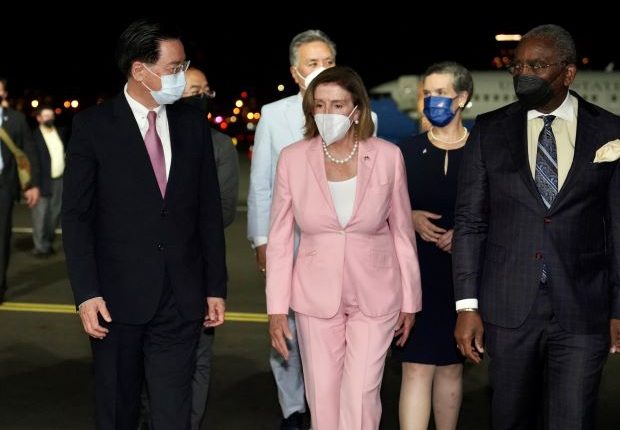Pelosi arrives in Taiwan, setting up high-stakes standoff with China

By Paul Mozur and Amy Chang Chien
TAIPEI — House Speaker Nancy Pelosi arrived in Taiwan on Tuesday (2), making the highest-level visit by a US official in 25 years and setting up a tense standoff with China that could lead to more aggressive military posturing.
The trip prompted a sharp response from China, which bristles at any perceived challenge to its claims on self-ruled Taiwan. China had repeatedly warned Pelosi not to make the visit, while the United States warned Beijing not to turn the moment into a crisis.
In a statement released shortly after her arrival, Pelosi said the visit was a sign of America’s “unwavering commitment” to supporting Taiwan’s democracy.
“America’s solidarity with the 23 million people of Taiwan is more important today than ever as the world faces a choice between autocracy and democracy,” she said, adding that the congressional visit did not contradict US policy on Taiwan.
Shortly after Pelosi’s arrival, China’s Foreign Ministry condemned the trip. The visit, it said in a statement, “seriously undermines China’s sovereignty and territorial integrity, seriously undermines the political foundation of Sino-US relations and sends a seriously wrong signal to the ‘Taiwan independence’ separatist forces.”
A separate statement issued by the Chinese Communist Party’s Taiwan Affairs Office said any attempt to seek independence by Taiwan would be “shattered by the powerful force of the Chinese people.”
Long a sore issue in a troubled US-China relationship, Taiwan — which has its own military and democratically elected government — has emerged as the front line in a geopolitical showdown over influence and power in Asia.
Under Xi Jinping, China’s most powerful leader in decades, Beijing has taken more aggressive military actions in the region and recently made strong claims over the strait separating Taiwan and China, one of the busiest shipping lanes in the world. Xi has called for unification with Taiwan as part of China’s national rejuvenation, even potentially by force.
The United States has sent a steady stream of senior officials to show solidarity with Taiwan. Recently, President Joe Biden has said he would act to defend Taiwan in the event of a conflict, but White House officials have repeatedly walked back those statements, saying a long-standing policy of “strategic ambiguity” on the defence of Taiwan remains in place.
After a nearly 2 1/2-hour phone conversation between Biden and Xi last week, China warned that the United States was “playing with fire” if it allowed the speaker’s visit to take place.
In anticipation of Pelosi’s trip, China’s military said Saturday (July 30) it would conduct drills with live ammunition off its coast at one of the narrowest points of the Taiwan Strait, just 80 miles from Taiwan. The next day, a Chinese air force spokesperson said the country would send fighter jets around Taiwan to demonstrate its ability to defend its sovereignty, without offering specifics on timing.
That raised the prospect that China could send planes over the median line that runs down the strait, as it did in 2020, when Alex Azar, then the US secretary of health and human services, visited Taiwan.
As the plane believed to be carrying Pelosi approached Taiwan, several Chinese state media outlets reported that Chinese Su-35 fighter jets were crossing the strait, providing few details, including how far the planes would travel or what they would do.
The United States on Monday (Aug 1) said it was concerned that China would use the potential visit to justify military action.
“There is no reason for Beijing to turn a potential visit consistent with long-standing US policy into some sort of crisis or conflict, or use it as a pretext to increase aggressive military activity in or around the Taiwan Strait,” John F. Kirby, a National Security Council spokesperson, told reporters.
-New York Times

